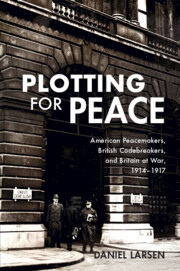Book contents
- Plotting for Peace
- Plotting for Peace
- Copyright page
- Dedication
- Contents
- Figures
- Map
- Graph and Table
- Dramatis Personae
- Preface
- Acknowledgements
- Maps
- Introduction
- 1 The First Year of War
- 2 Strategy
- 3 Negotiations
- 4 Deliberations
- 5 The Gamble
- 6 The Knock-Out Blow
- 7 The Fall of Asquith
- 8 Peace Moves
- 9 The Zimmermann Telegram and Wilson’s Move to War
- Conclusion
- Book part
- Notes
- Bibliography
- Index
5 - The Gamble
June–August 1916
Published online by Cambridge University Press: 26 March 2021
- Plotting for Peace
- Plotting for Peace
- Copyright page
- Dedication
- Contents
- Figures
- Map
- Graph and Table
- Dramatis Personae
- Preface
- Acknowledgements
- Maps
- Introduction
- 1 The First Year of War
- 2 Strategy
- 3 Negotiations
- 4 Deliberations
- 5 The Gamble
- 6 The Knock-Out Blow
- 7 The Fall of Asquith
- 8 Peace Moves
- 9 The Zimmermann Telegram and Wilson’s Move to War
- Conclusion
- Book part
- Notes
- Bibliography
- Index
Summary
Britain's great gamble began with the launch of the Somme Offensive. To extend their American assets, Asquith dislodged the spendthrift Lloyd George from the Ministry of Munitions by promoting him to War Secretary, replacing him with the more economy-minded Edwin Montagu. Startling talk of peace came from French President Raymond Poincaré, which British hardliners moved rapidly to bury. Otherwise, the question of American mediation only rumbled very quietly beneath the surface. British intelligence opened a new source of information with the discovery of the "Swedish Roundabout", unlocking the communications of the German Ambassador to the United States. The British military leadership continually reassured the government that the Somme Offensive was making great headway. As Romania moved to enter the war on the Allied side in August, the government was taken to unfamiliar heights of optimism: it finally seemed as if the Allies might be able to win the war on schedule.
Keywords
- Type
- Chapter
- Information
- Plotting for PeaceAmerican Peacemakers, British Codebreakers, and Britain at War, 1914–1917, pp. 137 - 158Publisher: Cambridge University PressPrint publication year: 2021

